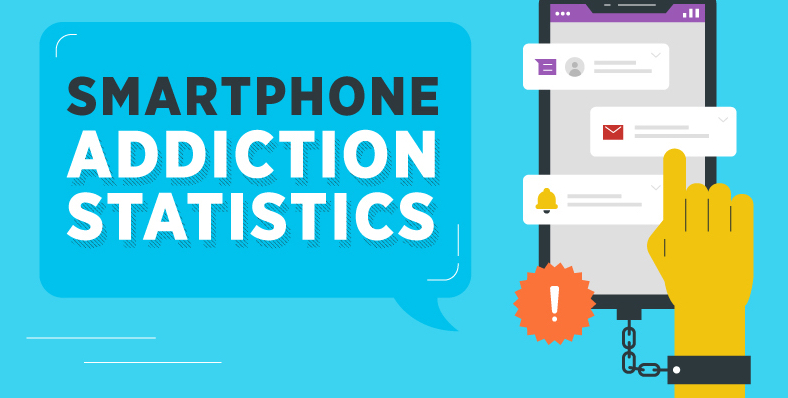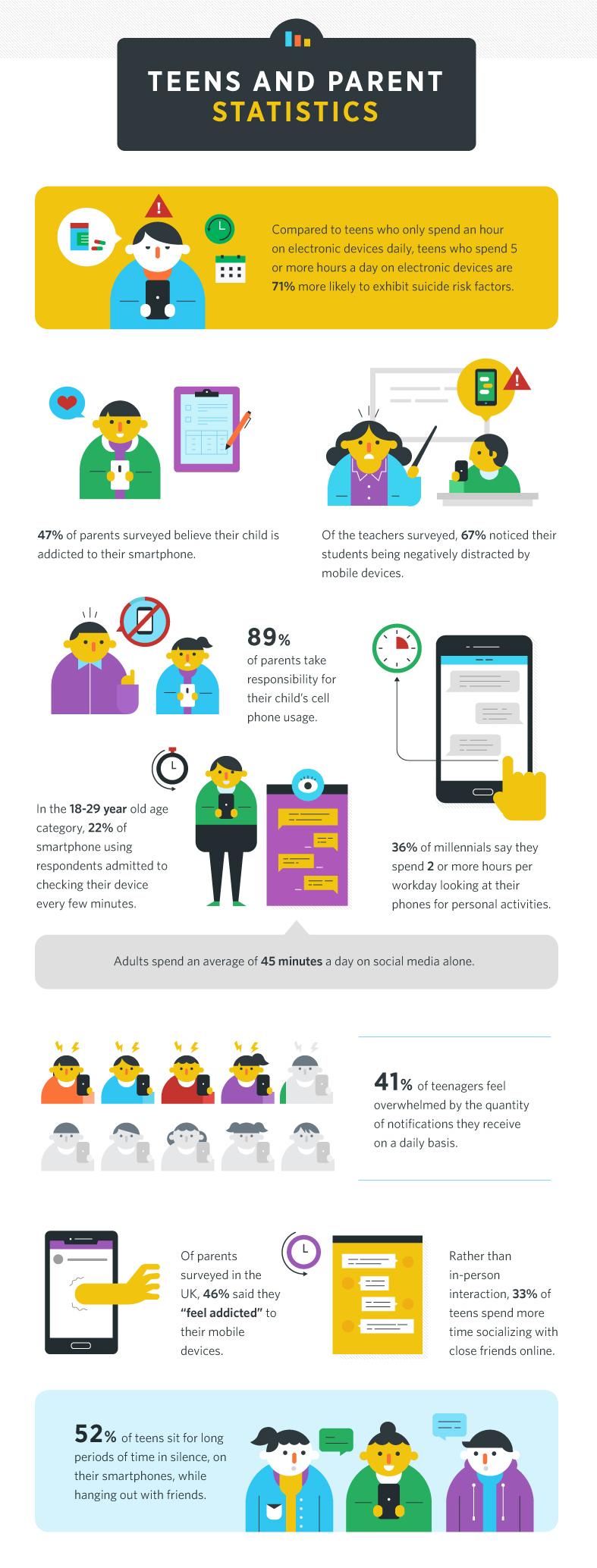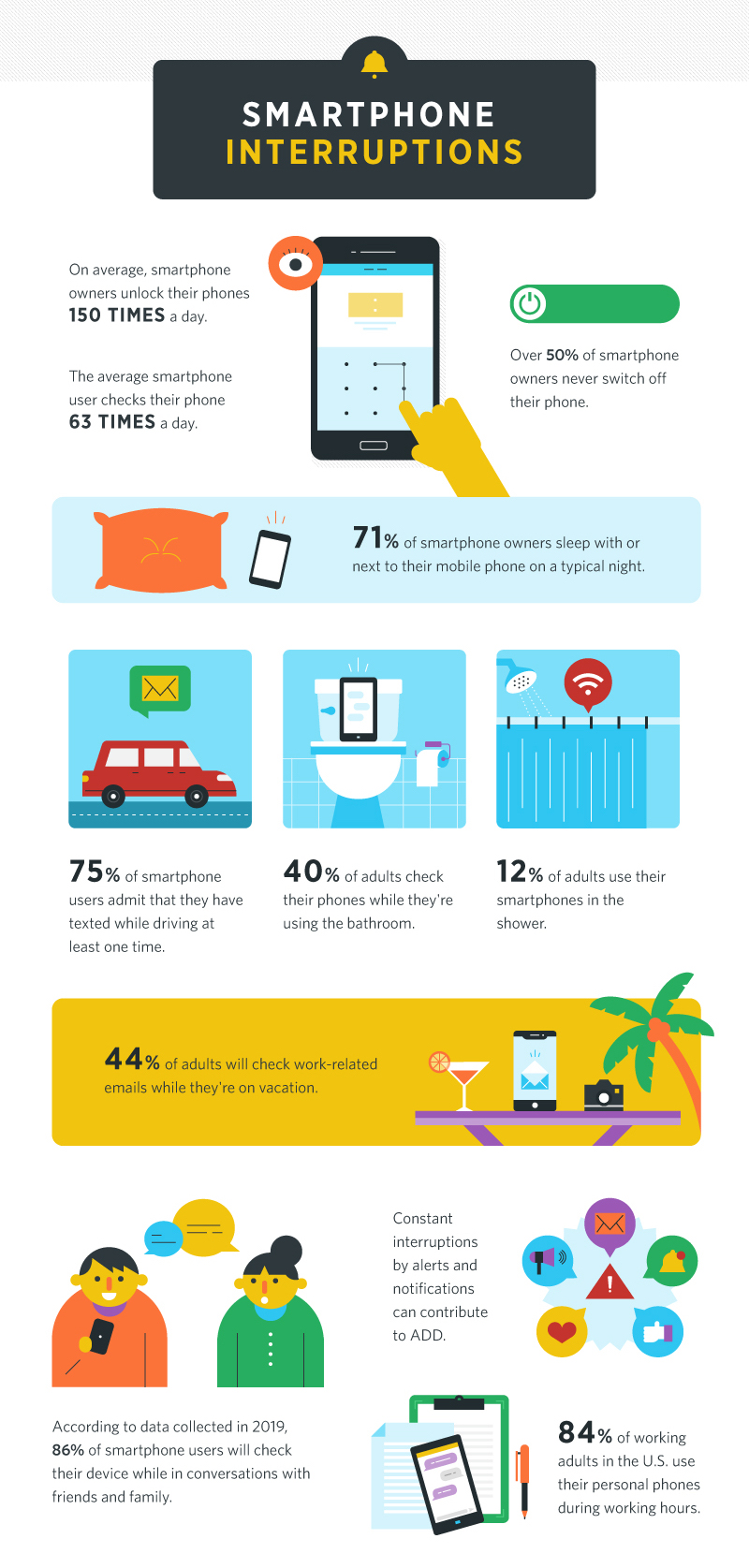44 Smartphone Addiction Statistics for 2024 [INFOGRAPHIC]

Updated April 16, 2024
Since the world saw the first iPhone in 2007, cell phone usage has steadily become an accepted part of our daily lives — and smartphone addiction statistics prove it. Fast forward to 2024, and we’re glued to our phones. Because we rely on our phones for communication and connection, it can be hard to gauge when high average screen time and cell time usage are in danger of leading to addiction.
Even though we’re a mass texting service and feel that text marketing brings great things to both businesses and consumers, these smartphone addiction statistics prove you shouldn’t have your phone with you all the time.
Here are all of the latest cell phone usage statistics, information on the negative effects, and tips on how to combat them.
Teens and parent smartphone addiction and cell phone usage statistics
- Compared to teens who only spend an hour on electronic devices daily, teens who spend five or more hours a day on electronic devices are 71% more likely to exhibit suicide risk factors.
- 47% of parents surveyed believe their child has a smartphone addiction.
- Of the teachers surveyed, 67% noticed their students being negatively distracted by mobile devices.
- 89% of parents take responsibility for their child’s cell phone usage.
- In the 18 to 29-year-old age category, 22% of smartphone-using respondents admitted to checking their device every few minutes. If that doesn’t say phone addiction, what does?
- 36% of millennials say they spend two or more hours per workday looking at their phones for social media, texting friends, playing games and interacting with text message marketing programs.
- 41% of teenagers feel overwhelmed by the number of text alerts they receive on a daily basis.
- 85% of teens surveyed claimed it can be difficult to stop using technology, such as the internet and smartphones, once they’ve started using it.
- 67% of teens reported losing sleep due to phone or internet use late at night.
- Of parents surveyed in the UK, 46% said they “feel addicted” to their mobile devices.
- Rather than in-person interaction, 33% of teens spend more time socializing with close friends online.
- 52% of teens sit for long periods of time in silence, on their smartphones, while hanging out with friends.

Excessive use can signal a phone addiction
Smartphone addiction can result in sleep deprivation, increased stress levels, depression, and anxiety. While being addicted to your digital devices doesn’t negatively impact your health as seriously as other types of addiction, it does indeed impact not only your mental health but your physical well-being.
-
-
- When divided by country, China has the highest smartphone/cell phone usage — followed by India and then the United States.
- As of 2024, 97% of American adults own a cellphone of some kind — most of them reply to texts within minutes.
- Approximately one-in-five American adults are “smartphone-only” internet users. This means that they own a smartphone, but do not have traditional home internet service.
- 48% of the population experience fear or anxiety when their phone battery drops below the 20% mark. This condition has a name—nomophobia—and it’s the fear of being detached from mobile connectivity.
- The average American looks at their phone for 4 hours and 37 minutes per day.
- The average smartphone owner will click, tap, or swipe their phone 2,617 times a day.
- When leaving their phones at home, 50% of respondents feel uneasy.
- 26% of accidents involving cars are caused by cell phone use while driving.
- 47% of Americans between the ages of 18 and 40 are concerned about the impact of their phone usage on their emotional health.
- 51% of Americans between the ages of 18 and 40 are concerned about the impact of their phone usage on their physical health.
- 56% of people believe using their phone less would bring happiness to their partner.
- When trying to reduce phone-related distractions, many users silence their phones or turn off notifications, but a Penn State study found that silencing phones actually increases the frequency of phone-checking.
- 87% of smartphone users check their devices within an hour of going to sleep or waking up.
- 69% of smartphone users check their devices within the first five minutes of waking up in the morning.
- More people have smartphones than toilets on a global scale.
- 20% of respondents in a cell phone usage survey would rather go without shoes for a week than be without their smartphones.
- Almost 40% of all consumers and 60% of 18-to 34-year-olds admit to using their phones too much.
- On average, people will spend 5 years and four months of their lifetimes on social media.
-

Daily interruptions from cell phone usage
-
-
-
-
- On average, smartphone owners unlock their phones 150 times a day.
- Over 50% of cell phone owners never switch off their smartphones.
- 71% of smartphone owners sleep with or next to their mobile phones on a typical night.
- 75% of cell phone users admit that they have texted while driving at least one time.
- 40% of adults check their phones while they’re using the bathroom.
- 12% of adults use their smartphones in the shower.
- 44% of adults will check work-related emails while they’re on vacation.
- The average smartphone user checks their phone 63 times a day.
- According to data collected in 2019, 86% of smartphone users will check their devices while in conversations with friends and family.
- The average American smartphone user reaches for their device 352 times per day.
- Even while in the same house, 30% of people will message their partner instead of starting a face-to-face conversation.
- Constant interruptions by text blasts and notifications can contribute to ADD.
-
-
-

COVID-19 smartphone addiction statistics
- 39. Internet use — and especially excessive internet use — increased with the COVID-19 pandemic. One international study found 33.37% of users have problematic internet use habits.
- 40. 44.3% of Koreans surveyed said their cell phone usage increased as a result of COVID-19.
- 41. The same study found the primary purpose of using a smartphone during COVID-19 was to communicate (49% of respondents). Other primary uses included using their phone to read the news (47.2%), mobile shopping (34.6%), and for photos and videos (29%).
- 42. 47.2% use their smartphone for reading news, 34.6% for mobile shopping, and 29% for photos and videos.
- 43. 37% of users say they are texting more during COVID-19 than ever before.
- 44. 61% of users began texting significantly more during COVID-19.
How to be healthier with your cell phone usage
If you’re uncomfortable with your attachment to your smartphone, there are ways to cultivate a healthier relationship with the technology in your life throughout 2024. Try limiting the time spent on your phone by using an app that tracks your daily cell phone usage and sends reminders to log off.
You can also access your average screen time in the settings of your phone. Another trick that helps limit smartphone use is to turn your color settings to black and white. Late-night scrolling isn’t as stimulating when you’re seeing black-and-white visuals, which encourages putting down your device.
If you’re a concerned parent looking to help your teen limit cell phone usage, communicate with your child. Make zones of your house “no phone zones,” or set limits on the hours of the day they’re allowed to use their phones. If you lead by example and find ways to limit your own smartphone use, your child will be more likely to be more cognizant of their own use as well.